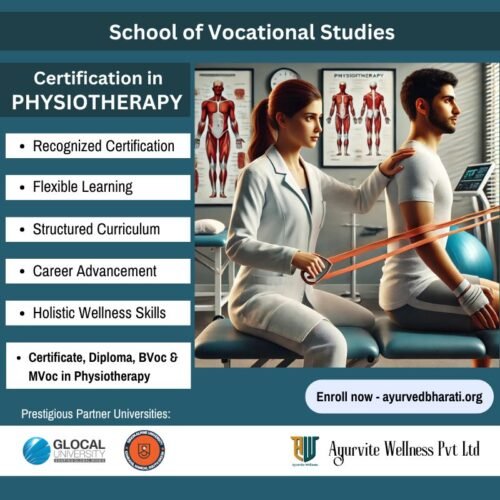Please click curriculum tab to start learning.
Upcoming live classes –
- Human Anatomy – 31 July 2025, 10:00 AM [JOIN HERE]
- Physiology & Biochemistry – 31 July 2025, 2:00 PM [JOIN HERE]
- Physiotherapy & First Aid – 01 August 2025, 10:00 AM [JOIN HERE]
Curriculum
- 10 Sections
- 144 Lessons
- 180 Days
Expand all sectionsCollapse all sections
- BVPT-101: Human Anatomy-I20
- 1.1[VIDEO] Orientation Class – Human Anatomy
- 1.2Chapter 1. Definition & Importance of Anatomy in Physiotherapy
- 1.3Chapter 2. Anatomical Terminology: planes, directions, and positions
- 1.4Chapter 3. Regions of Body, Cavities and Systems
- 1.5Chapter 4. General Embryology
- 1.6Chapter 5. Overview of Human Body Systems
- 1.7Chapter 6. Integration of Body Systems & Their Functional Significance
- 1.8Chapter 7. Skeletal System
- 1.9Chapter 8. Muscular System
- 1.10Chapter 9. Joints and Ligaments
- 1.11Chapter 10. Cardiovascular System
- 1.12Chapter 11. Respiratory System
- 1.13Chapter 12. Integration and Clinical Applications
- 1.14Video 01. Introduction To Basic Anatomy20 Minutes
- 1.15Video 02. Overview of the Musculoskeletal System25 Minutes
- 1.16Video 03. The Spine15 Minutes
- 1.17Video 04. The Thoracic and Upper Limb
- 1.18Video 05. Pelvic and Hip
- 1.19Video 06. Knee
- 1.20Video 07. Foot and Ankle
- BVPT-102: Physiology & Biochemistry12
- 2.1[VIDEO] Orientation Class – Physiology & Biochemistry
- 2.2Chapter 1. Introduction to Physiology and Biochemistry
- 2.3Chapter 2. Cellular Physiology
- 2.4Chapter 3. Musculoskeletal Physiology
- 2.5Chapter 4. Cardiovascular Physiology
- 2.6Chapter 5. Respiratory Physiology
- 2.7Chapter 6. Biochemical Principles and Metabolism
- 2.8Chapter 7. Clinical Applications and Case Studies
- 2.9Video 01. Homeostasis and Fluid Compartments
- 2.10Video 02. Regulation of Homeostasis
- 2.11Video 03. Transporters Pumps and Channels
- 2.12Video 04. Solute & Water Transport17 Minutes
- BVPT-103: Orientation in Physiotherapy & First Aid22
- 3.1[VIDEO] Introduction to the subject – Orientation of Physiotherapy & First Aid
- 3.2Chapter 1: Part 1. Introduction to Physiotherapy – History and Evolution of Physiotherapy
- 3.3Chapter 1. Part 2. Scope of Physiotherapy
- 3.4Chapter 1. Part 3. Ethical and Legal Aspects
- 3.5Chapter 2. Basic Concepts in Physiotherapy Part 1. Understanding Movement and Function
- 3.6Chapter 2. Part 2. Assessment Techniques
- 3.7Chapter 2. Part 3. Treatment Modalities
- 3.8Chapter 3. Introduction to First Aid Part 1. Principles of First Aid
- 3.9Chapter 3. Part 2. First Aid Kit Essentials
- 3.10Chapter 3. Part 3. Role of a First Aider
- 3.11Chapter 4. Management of Common Injuries Part 1. Soft Tissue Injuries
- 3.12Chapter 4. Part 2. Fractures and Dislocations
- 3.13Chapter 4. Part 3. Burns and Scalds
- 3.14Chapter 5. Cardiopulmonary Resuscitation (CPR) and Emergency Response Part 1. Understanding CPR
- 3.15Chapter 5. Part 2. Automated External Defibrillator (AED)
- 3.16Chapter 5. Part 3. Emergency Response Planning
- 3.17Chapter 6. Handling Medical Emergencies Part 1. Respiratory Emergencies
- 3.18Chapter 6. Part 2. Cardiovascular Emergencies
- 3.19Chapter 6. Part 3. Poisoning and Overdose
- 3.20Chapter 7. Environmental and Situational Emergencies Part 1. Heat and Cold-Related Illnesses
- 3.21Chapter 7. Part 2. Drowning and Water-Related Incidents
- 3.22Chapter 7. Part 3. Disaster Preparedness
- BVES-151: Environmental Studies17
- 4.11. Introduction to Environmental Science
- 4.22. Human Impact and Resource Management
- 4.33. Energy Resources
- 4.44. Ecosystem Dynamics
- 4.55. Biodiversity and Conservation
- 4.66. Types of Environmental Pollution
- 4.77. Solid Waste Management
- 4.88. Social Issues and the Environment
- 4.99. Water and Resource Management
- 4.1010. Resettlement and Rehabilitation
- 4.1111. Ethics and Legislation
- 4.1212. Human Population and Welfare
- 4.1313. Natural Disasters
- 4.1414. Man-Made Disasters
- 4.1515. Accidents and Structural Failures
- 4.1616. War and Terrorism
- 4.1717. Disaster Preparedness and Management
- [VIDEO] Anatomy & PhysiologyVideo lectures by Laura S. Kabiri, PT, DPT, PhD, Department of Kinesiology, Rice University26
- 5.11. Introduction to the Human Body – Song2 Minutes
- 5.22. Introduction to Anatomy & Physiology11 Minutes
- 5.33. Anatomical Terminology10 Minutes
- 5.44. Level of Organization in Human Body Intro Song2 Minutes
- 5.55. Introdcution to Chemistry of Life10 Minutes
- 5.66. Cells14 Minutes
- 5.77. Tissues9 Minutes
- 5.88. Introduction to Support & Movement2 Minutes
- 5.99. Skeletal: Function, Classification, & Structures8 Minutes
- 5.1010. Skeletal: Formation, Development, & Repair8 Minutes
- 5.1111. Skeletal: Axial Skeleton12 Minutes
- 5.1212. Skeletal: Appendicular Skeleton14 Minutes
- 5.1313. Skeletal: Joints9 Minutes
- 5.1414. Muscular: Control & Skeletal14 Minutes
- 5.1515. Muscular: Cardiac, Smooth, & Development7 Minutes
- 5.1616. Muscular: Muscles of the Axial Skeleton9 Minutes
- 5.17Muscular- Muscles of the Upper & Lower Extremities13 Minutes
- 5.1817. Cardiovascular: Heart & Conduction11 Minutes
- 5.1918. Cardiovascular: Cardiac Cycle & Physiology11 Minutes
- 5.2019. Cardiovascular: Blood10 Minutes
- 5.2120. Cardiovascular: Blood Vessels9 Minutes
- 5.2221. Cardiovascular: Blood Pressure & Diseases10 Minutes
- 5.2322. Respiratory: Organs & Structures9 Minutes
- 5.2423. Respiratory: Respiration12 Minutes
- 5.2524. Respiratory: Disease7 Minutes
- 5.2625. Respiratory- Gas Exchange & Transport7 Minutes
- [VIDEO] Foundation of Orthopaedic Manual Therapy and Exercise By OMTA13
- 6.11. Introduction27 Minutes
- 6.22. Understanding pain. Simple clinical guide for physiotherapists1 Hour
- 6.33a. Keys to meaningful Subjective examination60 Minutes
- 6.43b. Assessment sheet. Subjective assessment57 Minutes
- 6.54a. Aims of physical examination and must-should-could system50 Minutes
- 6.64b. Mechanical Diagnosis – Overview and critical discussion58 Minutes
- 6.74c. Repeated Movement testing cervical spine demonstration6 Minutes
- 6.84d. Repeated movement testing Lumbar spine demonstration7 Minutes
- 6.94e. Passive Physiological Intervertebral Mobilizations Cervical Spine16 Minutes
- 6.104f. Passive inter-vertebral mobilisation as a test and treatment30 Minutes
- 6.115a. Testing neural mechanosensitivity – Neurodynamics60 Minutes
- 6.125b. Clinical discussion of Upper limb NTT8 Minutes
- 6.135c. Clinical discussion of lower limb NTT14 Minutes
- [VIDEO] Physio Masterclasses5
- [VIDEO] Clinical Dry Needling (CDN)7
- 8.11. Guideline for Safe and Effective Practice of Dry Needling39 Minutes
- 8.22. Safe Practice Guidelines of Dry Needling21 Minutes
- 8.33. CDN – Application Procedure (Step by step guide)19 Minutes
- 8.44. Needling Arm Muscles10 Minutes
- 8.55. Deltoid Dry Needling6 Minutes
- 8.66. Biceps Brachii Dry Needling6 Minutes
- 8.77. Triceps Brachii Dry Needling6 Minutes
- Final University ExamInformation related with university exam will be notified here.1
- BVPT-104: English & CommunicationCurrently removed from university syllabus of BVoc 1st Sem, but added here for knowledge. Learning this subject is not mandatory now. There will be no exam for this subject.21
- 10.11. Communication Process: Definition, elements, and models of communication
- 10.22. Barriers to Effective Communication
- 10.33. Types of Communication
- 10.44. Effective Communication Strategies
- 10.55. Communicating in English
- 10.66. Importance of Listening
- 10.77. Organs of Speech
- 10.88. Vowels & Vowel Sounds Practice
- 10.99. Consonants & Consonant Sounds Practice
- 10.1010. Pronunciation
- 10.1111. Vocabulary Building
- 10.1212. Common Pronunciation Challenges
- 10.1313. Speaking as a Language Skill
- 10.1414. Introduction to Business Communication
- 10.1515. Written Communication
- 10.1616. Oral Communication in Business
- 10.1717. Cross-Cultural Communication
- 10.1818. Public Speaking
- 10.1919. Presentation Skills
- 10.2020. Use of Visual Aids
- 10.2121. Overcoming Stage Fright
Instructor


